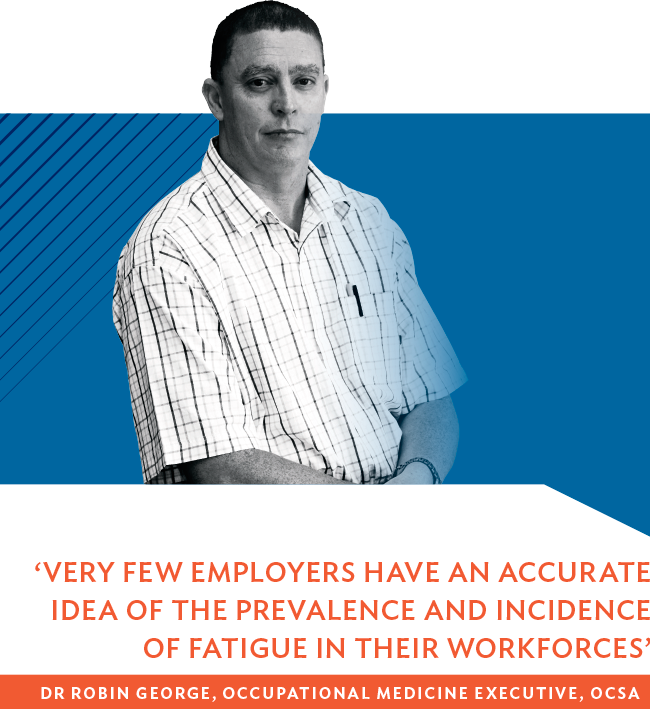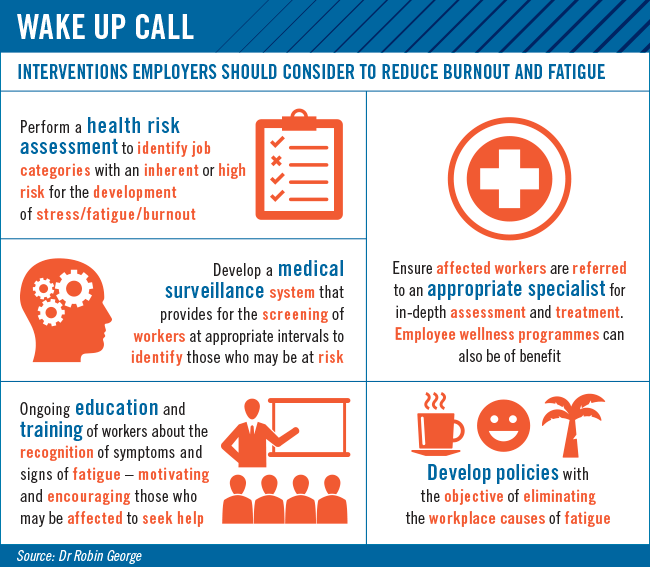‘This shouldn’t – indeed couldn’t – happen to me,’ writes Richard Hawkey in his autobiography, Life Less Lived. ‘I have a good life, happy marriage, great children and enough remote controls to make a modest coffee table disappear.’ Yet, ‘I was shockingly, embarrassingly ignorant about how damaging my poor stress management was’. Self-described as Mr Average (‘I buy clothes from the “medium” rack and have beige carpets in my house’), Hawkey’s account of burnout, descent into depression and subsequent recovery is remarkable, perhaps, in its lack of remarkableness. A Gautenger with more than a decade of senior-management experience in the corporate world, he truly was your average suburban working dad. Until he wasn’t.
Some of the symptoms described by Hawkey are (paradoxically) emotional numbness, bursts of anger, feelings of worthlessness and deep, chronic fatigue. This last symptom bears scrutiny on its own, as its effect on our psyche and quality of life (not to mention productivity) can be devastating.
While chronic fatigue syndrome and burnout are sometimes used interchangeably, they’re not quite the same condition. Coined by psychologist Herbert Freudenberger in 1974, ‘burnout’ is psychological stress characterised by a lack of enthusiasm, helplessness or hopelessness and cynicism, as well as exhaustion or chronic fatigue, resulting in reduced efficiency at work.
Chronic fatigue syndrome, meanwhile, is a physical condition that can have many different causes (stress is one, bacterial or viral are others). However, its synonymity with burnout means the conditions are often intimately linked in a work environment.
‘Fatigue is the state of feeling very tired, weary or sleepy, resulting from insufficient sleep, prolonged mental or physical work, or extended periods of stress or anxiety,’ says Dr Robin George, national occupational medicine executive at Occupational Care South Africa. ‘Boring or repetitive tasks can intensify feelings of fatigue, which falls into one of two categories: acute or chronic. Acute fatigue results from short-term sleep loss or short periods of heavy physical or mental work. The effects of acute fatigue are of short duration and usually can be reversed by sleep and relaxation.
‘Chronic fatigue syndrome is the constant, severe state of tiredness that is not relieved by rest. The symptoms of chronic fatigue syndrome are similar to the flu, last longer than six months and impact your ability to function in daily life.’
It’s hardly a newsflash that stress can contribute massively to the development of fatigue and – by extension – burnout, says George. ‘Where people are exposed to ongoing stress and develop increasing severity of stress, they may eventually experience fatigue and burnout, at which point they are unable to perform work and/or day-to-day activities of living.’
Traditionally, chronic fatigue in the workplace has been associated with ‘shift’ workers – for example, nurses and miners – who work unusually long hours under stressful conditions, particularly at night. (For this reason, it is now compulsory for mining companies, in terms of the Mine Health and Safety Act, to develop a code of practice for the management of fatigue, says George.) But increasingly, this condition is creeping into less obvious arenas of employment, including the average office worker.
It’s happening at a younger age too. A 2015 study by AfriForte (a research unit at North-West University) found that 17% of people under the age of 30 are at serious risk of burnout.
Technological advances have without doubt improved our lives in many ways (better healthcare, greater connectivity and access to information…) but it has also increased the pace of our lives beyond our ability to cope.
Along with economic pressures on many companies’ bottom lines, these influences have merged into a toxic culture of stress and scarcity: there never seems to be enough time or money available to just relax, to exhale, to stop and smell the proverbial roses. In short, to enjoy life.
Whereas once we could at least leave our work at the office, now it follows us home in the form of emails and instant messaging on our phones and home computers, and we’re constantly bombarded with news from mainstream and social media sites – an excess of which has its own special label: ‘digital burnout’. And many of us have given up attempting to keep up with the deluge of emails that seems to have become part of the fabric of working life.
Along with this information inundation and pressure to ‘perform’ has come a strong taboo against saying anything other than ‘yes, I can’ to any given task when, actually, the opposite is true. Drawing boundaries and admitting to our limited capacities is seen – though never explicitly articulated – as an admission of failure. A fault. The fact that many wear a state of intense stress as a badge of honour is perhaps the most alarming testament to our perverse and pervasive culture of pressure.
A certain amount of tension is healthy and actually boosts productivity – but too much is a recipe for disaster. ‘It is fairly well known that the type A personality thrives when exposed to stress,’ according to George. ‘However, the tipping point for most people occurs where the levels overwhelm their coping mechanisms.’
Persistent lethargy is an excellent sign of impending burnout. While causes of this malaise can range from viral, bacterial, parasitic and hormonal, once ruled out, chronic stress is the most likely culprit. ‘Toxic work situations can wipe out one’s adrenal function,’ says occupational wellness practitioner Dr Marina Botha from the Bedford Wellness Centre. ‘The adrenals are one’s battery pack – a source of energy. Stress can suppress that source of energy.’
Other signs, according to the Mayo Clinic, that you may be on the road to burnout include disinterest in your work, apathy, doubts about your competence, lack of satisfaction in your achievements, using alcohol or drugs to numb your feelings, less sleep or erratic sleep patterns, and unexplained aches and pains, to name a few.
So what is to be done? How can we take control of our mental and physical health to prevent burnout, revive flagging energy levels and regain our verve for life? The answer is simple in its essence, though potentially complex in its application, because we are complex beings.
The most obvious place to start is with a balanced diet that maintains your energy levels (so, no skipping breakfast) – an erratic diet comprising refined or junk food can wreak havoc on your blood sugar levels and exacerbate the stress symptoms you may already have. Staying hydrated and regular exercise is also recommended, as this assists with relaxation and may also help you sleep better.
These are basic steps anyone can take to improve their body’s ability to cope with stress. But what about the mind? That’s the complex bit.
Hawkey credits having a strong support system in place (including professional assistance) with his recovery, as well as focusing on rediscovering what it is that really brings him joy, without concern for the activity’s commercial value.
However, this won’t remove the source of stress at work, which may vary from a monstrous workload to long hours, dysfunctional dynamics, poor job fit, monotony, a lack of decision-making control…
These are more complex problems that may require the involvement of your employers, or perhaps an outside party such as a life or business coach to help empower you to find a solution.
To this end, Hawkey and psychologists Dr Colinda Linde and Dr Monica Mercer launched Vitals Proactive Stress Management (vitalstest.com), an online tool that helps employers empower employees who may be experiencing burnout symptoms, so that they can take practical steps to ‘help individuals become more self-aware and build their personal resilience’.
Hawkey says: ‘The Vitals test has also now been used in academic research projects at Maastricht University in Holland and Wits Business School, and shown to have very high reliability as a tool.’
Internationally, media mogul Arianna Huffington recently added another wing to her empire in the form of Thrive Global (thriveglobal.com), a venture that aims to ‘end the escalating stress and burnout epidemic with sustainable, science-based solutions’ by offering well-being resources and articles. (The jury is still out as to whether they will achieve their goals, though the Thrive-branded pillow with the words ‘sleep your way to the top’ is cute.)
Unfortunately, burnout doesn’t appear to be a huge priority for SA businesses. ‘Based on my experience, very few employers have an accurate idea of the prevalence and incidence of fatigue in their workforces,’ says George. ‘So it’s not surprising that very few employers have systems and mechanisms to prevent fatigue and burnout.’ He adds that before employers embark on implementing preventative measures, they need to understand the extent of the problem within their workforces.
‘This requires commitment from the highest levels of management within the organisation. Management needs to improve its understanding of the nature of the problem through ongoing sensitisation and education, and commit to providing the resources to manage the problem. All employers should develop a fatigue-management policy.’











